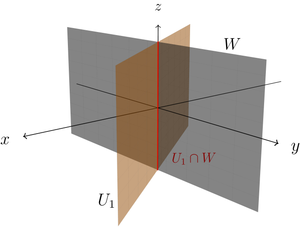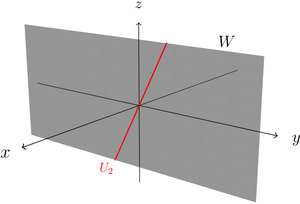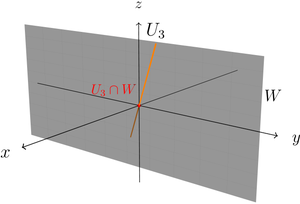Union and intersection of vector spaces – Serlo
Motivation
[Bearbeiten]We know various operations to construct a new set from given sets. If is a family of sets, we can, for example, form the average or the union . Assume that the are also subspaces of a larger vector space . This means that the are non-empty subsets of , which are closed under addition and scalar multiplication. Are the average and the union of then also subspaces of ?
Intersection of vector spaces
[Bearbeiten]Is the intersection of subspaces of a vector space again a subspace? To answer this question, let us first consider the case of two subspaces and look at examples in .
- Let us first look at the two planes and (the y-z-plane). In the image we can see that its intersection is the z-axis , i.e. a subspace of .
- The second image shows that the intersection of the line with the y-z plane is also a line, namely .
- If we intersect the y-z plane with the line instead, we see that the intersection only contains the zero vector. This is also a subspace of .
-
Intersection of two planes
-
Intersection of a plane with a line
-
Intersection of a plane with a line
In the examples, the intersection of the two subspaces is always a subspace of . We now show that this also applies to general subspaces of any vector space.
Theorem (Intersection of vector spaces)
Let and be two subspaces of a vector space . The intersection of and is a subspace of .
Proof (Intersection of vector spaces)
First, we have to establish the three subspace criteria:
Proof step: is not empty
Since and are subspaces, we have and . Thus, , and therefore .
Proof step: is closed under addition.
Let now be arbitrary. Then and apply. As the subspaces and are closed under addition, we get and . This also means .
Proof step: is closed under scalar multiplication.
Let and be arbitrary. Then we have and . Since the subspaces and are closed under scalar multiplication, we obtain and . Thus, also .
Hint
We have seen that is a subspace of . Because , the intersection is also a subspace . From this we get . Similarly, follows from . This makes intuitively sense: if we intersect one subspace with another, its dimension cannot possibly become larger.
We have shown that the intersection of two subspaces is again a subspace. However, at no point in the proof is it relevant that there are only two or finitely many subspaces involved. In fact, the statement applies to any family of subspaces.
Exercise (Arbitrary intersection of vector spaces)
Let be an arbitrary index set and a family of subspaces of a vector space . Then, the intersection is a subspace of .
Solution (Arbitrary intersection of vector spaces)
Let and let be subspaces of the -vector space . The intersection of all vector spaces is again a vector space.
Proof step: is not empty.
Since the are subspaces, we have for all and therefore . Thus is not empty.
Proof step: is closed under Addition.
Let . Then holds for all . Because the are vector spaces, they are closed under addition and hence is valid for all . This means .
Proof step: is closed under scalar multiplication.
Let and . Then holds for all . Since the are vector spaces, they are closed under scalar multiplication and is valid for all . Hence .
Union of vector spaces
[Bearbeiten]Is the union of subspaces of a vector space a vector space again? Let us first look at an example.
Example (Coordinate axis cross is not a subspace)
Let . We choose the coordinate axes and as subspaces. Their union is the axis cross in . Based on the figure, we can already surmise that this is not a subspace of : There are two "directions", but at the same time is not the two-dimensional plane. And indeed, the two vectors and are in , but their sum is not in the union. Therefore, is not a subspace of .

So we see that the union of two subspaces is generally not a subspace. Is this always the case?
Example (Union of vector spaces is again a vector space)
We consider the two subspaces and of . As we have . Therefore and the union of the two subspaces is again a subspace.

The union of two subspaces is therefore in some cases, but not always, a subspace. In the example, was contained in , so that was a subspace. This always works: If two subspaces are given and one of them is contained in the other, then the union is equal to the larger of the two, i.e. a subspace again.
This is indeed the only case in which the union of two subspaces is again a subspace, as the first example with the coordinate axes makes clear: If and , then the union will not be closed under addition. There will then always exist two vectors with and . The sum thus contains a part that is not in and therefore cannot be in : Otherwise, would also be true. The same applies to .
We therefore have the following criterion for determining when the union of two subspaces is a subspace.
Theorem (Condition for the union of two vector spaces to be a vector space again)
Let be a vector space over a field and let and be two subspaces of . Then is a subspace of if and only if or holds.
Proof (Condition for the union of two vector spaces to be a vector space again)
Proof step: If is a subspace of , then we have or .
We prove the statement by contradiction: Assume that neither nor is true. We show that is then not a subspace of . Instead, we find two elements , so that :
Since , there exists an element that is not contained in . Similarly, since , there exists a that is not contained in .
Thus, . But the sum is neither in nor in : If , then , in contradiction to the choice of . Here we have used the fact that implies also and that is closed under addition. In the same way, you can see that does not lie in .
Therefore, applies. This means that the union is not closed under addition, i.e. it is not a subspace.
Proof step: If or , then is a vector space
If , then , so the union is a subspace. Similarly, it follows from that is a subspace.
The proof of the theorem shows that the property of being a subspace fails due to addition. The scalar multiplication on was not relevant in the proof. In fact, is always closed under scalar multiplication, even if the union is not a subspace: If and , say , then holds, since is closed under scalar multiplication as a subspace. The case is analogous.
Since is a vector space and are subspaces, forms a group and subgroups. We have thus effectively shown that is a subgroup of if and only if or holds. There is a more general statement about (not necessarily commutative) groups. The proof is quite analogous to the proof for subspaces that we have seen above.
Theorem (Union of subgroups)
Let be a group and subgroups. Then is a subgroup of if and only if or holds.
The union of subspaces and is generally not a subspace. However, you can define the smallest subspace that contains . This subspace is the subspace sum .




































































































